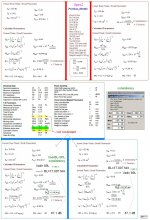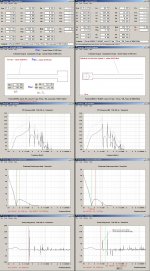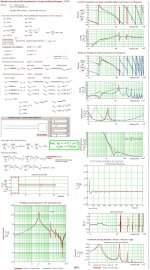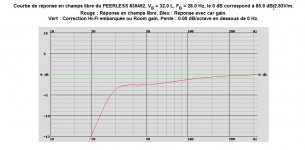I am simulating my Peerless XLS10 830452 in WinISD and I get a recommendation for really small enclosures.
I decided to ignore the default recommendation of a 4.9lt enclosure tuned at 45Hz or something and I am simulating a box at approximately 17lt tuned at around 28Hz.
I plan to use a slot vent of 3cm height and 22cm width (to match the box depth) and I get a 1.3 meters long port (approximately).
Am I correct assuming that the vent volume is not included in the calculations? that means that I may build a 17lt box (internal volume) as long as the port will be external right?
If this is the case, I have already designed a box that the vent starts from one corner of the box and circles around it on all sides.
I end up with a box approximately 40X44X27 outer dimensions with the 17lt chamber in the middle and the slot vent (that has a net volume of an additional 6.6lt) around it.
Is that correct?
I decided to ignore the default recommendation of a 4.9lt enclosure tuned at 45Hz or something and I am simulating a box at approximately 17lt tuned at around 28Hz.
I plan to use a slot vent of 3cm height and 22cm width (to match the box depth) and I get a 1.3 meters long port (approximately).
Am I correct assuming that the vent volume is not included in the calculations? that means that I may build a 17lt box (internal volume) as long as the port will be external right?
If this is the case, I have already designed a box that the vent starts from one corner of the box and circles around it on all sides.
I end up with a box approximately 40X44X27 outer dimensions with the 17lt chamber in the middle and the slot vent (that has a net volume of an additional 6.6lt) around it.
Is that correct?
T/S parameters for Peerless 830452
Znom 8 ohm
Re 3.4 ohm
Le 4.3 mH
fs 18.6 Hz
Qms 2.66
Qes 0.18
Qts 0.17
Mms 139.3 g
Cms 0.52 mm/N
Sd 333 cm2
BL 17.5 N/A
Vas 80.2 ltrs
Xmax 12.5 mm peak
Voice Coil Ø 51 mm
Sensitivity
2.83V / 1m 88.4 dB
Power (IEC) 200 W
Magnet weight 2.42 kg
Znom 8 ohm
Re 3.4 ohm
Le 4.3 mH
fs 18.6 Hz
Qms 2.66
Qes 0.18
Qts 0.17
Mms 139.3 g
Cms 0.52 mm/N
Sd 333 cm2
BL 17.5 N/A
Vas 80.2 ltrs
Xmax 12.5 mm peak
Voice Coil Ø 51 mm
Sensitivity
2.83V / 1m 88.4 dB
Power (IEC) 200 W
Magnet weight 2.42 kg
I think there is something wrong with the T/S data.
VAS=80l and Fs=18.6Hz seems incompatible with 139gm for mms.
You are mistaken, the parameters are correct.
I think there is something wrong with the T/S data.
VAS=80L and Fs=18.6Hz seems incompatible with 139gm for mms.
Hi,
Those three numbers imply a particular Sd, not incompability. Fs
and Mms imply a stiffness, to convert that to Vas you need the Sd.
rgds, sreten.
Thanks, that was very helpful.Posting link for driver T/S parameters PEERLESS 830452 (v.?) SUBWOOFER 10" XTRA-LONG-STROKE 8 ohm here
Can someone tell me how I figure out speaker displacement? (I hope I am saying this right, I mean the volume the driver takes that I will have to add to the total box volume). Is should be a measurement in liters or cu.ft.
Is it one of the parameters listed? There some of those that I do not understand.
Or should I just add a liter or two and be done with it?
Is it one of the parameters listed? There some of those that I do not understand.
Or should I just add a liter or two and be done with it?
Can someone tell me how I figure out speaker displacement? (I hope I am saying this right, I mean the volume the driver takes that I will have to add to the total box volume). Is should be a measurement in liters or cu.ft.
Is it one of the parameters listed? There some of those that I do not understand.
Or should I just add a liter or two and be done with it?
Hi SpirosZ,
I've been using ~1.8 L Vd for my designs....Its not listed but can easily estimated using the given driver dimensions and IMO only necessary to add if Vb< ~20L is a closed box.
Have a look at the T/S parameters...IME: This driver is by the driver manufacturer advertised (and here at diyAUDIO) with parameters that has low consistency. You want reliable input data when designing quarter-wave dependent speakers, at least with tolerances within 5 %. The first of picture is about the T/S.
This driver has parameters just above this limit and IMO requires a DIY measurement before quarter-wave simulations but for a closed box design the tolerance is of a minor issue and when below ~10%: 'Hits diminishing returns' for the eventually resulting performance.
You have simulated your box using WinISD...not that suitable for this kind of design: The second and third submitted pictures are simulations of your design using Superior Programs(IMO) and when interpreted correctly are far more reliable...Compare!
b
Attachments
Hi SpirosZ,
I've been using ~1.8 L Vd for my designs....Its not listed but can easily estimated using the given driver dimensions and IMO only necessary to add if Vb< ~20L is a closed box.
Have a look at the T/S parameters...IME: This driver is by the driver manufacturer advertised (and here at diyAUDIO) with parameters that has low consistency. You want reliable input data when designing quarter-wave dependent speakers, at least with tolerances within 5 %. The first of picture is about the T/S.
This driver has parameters just above this limit and IMO requires a DIY measurement before quarter-wave simulations but for a closed box design the tolerance is of a minor issue and when below ~10%: 'Hits diminishing returns' for the eventually resulting performance.
You have simulated your box using WinISD...not that suitable for this kind of design: The second and third submitted pictures are simulations of your design using Superior Programs(IMO) and when interpreted correctly are far more reliable...Compare!
b
Thanks for going into all that trouble for me. I do not expect a free program to be the best in the market. It is user friendly though and easy to understand.
Your simulation on Hornresp may be perfect but to be honest I do not understand a thing.
I really don't need a program that shows me all the math behind it's findings. Just the size of the box and the size of the port would be fine with me.
All those mathematics equations only make me dizzy.
Last edited:
Posting link for driver T/S parameters PEERLESS XLS-P830452 (v.2010) SUBWOOFER 10" here
WOW!
Thanks for that!
That is a completely different driver.
I wonder why they keep the same name...
Box needs to be a little bigger and port length shorter.
WinISD showed me a nice slightly sloping response on a 32lt box tuned at 28Hz with 2 47mm 37,3 cm long ports.
- Status
- This old topic is closed. If you want to reopen this topic, contact a moderator using the "Report Post" button.
- Home
- Loudspeakers
- Subwoofers
- WinISD & vent volume.



